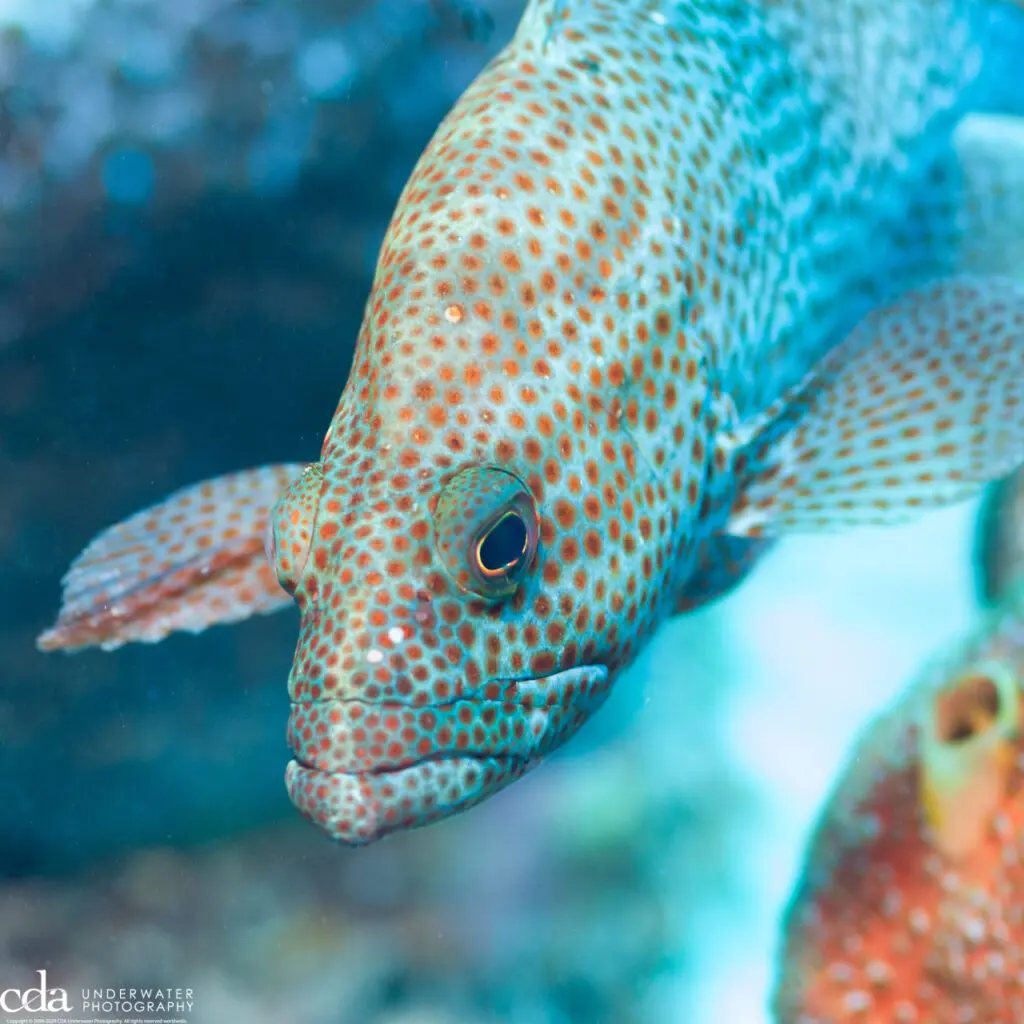Let’s just start out with the obvious question: who’s in charge of naming marine animals, and can we go have a drink with them? They sound fabulous! We all know that the ocean is a vast and mysterious world, teeming with creatures whose names often reflect their unique anatomy, behavior, or cultural significance. Some of these names even resonate with themes of identity, gender, and sexuality, making them particularly fascinating. Let’s dive into this underwater lexicon, starting with species that hold relevance to modern LGBTQIA+ communities.

Red Hind
Epinephelus guttatus
Supposedly named based on the speckled nature’s resemblance to a type of deer in England called a “hind” and not to someone’s hind quarters, these are the fish who invented “resting bitch face.” They are actually very curious about divers and can often be seen perched on coral bommies and under ledges watching divers swim by. Their reddish color fades to black at depth unless they are lit by a torch or a strobe. Image by Fernando Herranz Martín, GPL downloaded from Wikimedia Commons 2025-03-07

Slippery Dick
Halichoeres bivittatus
The slippery dick (we didn’t giggle, you did), is a type of wrasse named for its elongated, slipper-like body. This fish is a sequential hermaphrodite, meaning it can change sex during its lifetime. This biological adaptability mirrors the fluidity of gender identity, making it a compelling symbol for discussions around gender diversity. And dare we say it, it’s fun to play with when you find one on the reef? Image by Brian Gratwicke, CC BY 2.0 downloaded from Wikimedia Commons 2025-03-07

Queen Angelfish
Holacanthus ciliaris
The queen angelfish is named for its regal appearance, with vibrant colors and a crown-like pattern on its head. While its name doesn’t directly reference gender roles, the term “queen” has deep meaning in our communities, often symbolizing pride and self-expression. Remember, the first ones to throw stones at the Stonewall Riots were all fabulous queens. You go girl! applies to all of these magnificent fish. Image by Pauline Walsh Jacobson, CC BY 4.0 downloaded from Wikimedia Commons 2025-03-07

Queen Triggerfish
Balistes vetula
Similar to the queen angelfish, the queen triggerfish gets its name from its striking appearance and “queenly” demeanor. They are curious and will come right up to a diver, as if to ask “Bitch, what are you doing on this side of town?” Its bold colors and patterns make it a standout in coral reefs, embodying individuality and confidence. Lookout for this beauty and don’t point if you find one (that’s just rude!) Plus, those pouty lips hide massive teeth! Image by Aquaimages CC BY-SA 2.5 downloaded from Wikimedia Commons 2025-03-07

Princess Parrotfish
Scarus taeniopterus
The princess parrotfish is named for its vibrant, princess-like hues and its beak-like teeth, which resemble a parrot’s beak. They are recognizable by the “sash” of color they wear on their flanks. No crowns for this fish, but we bet there’s a tiara hidden somewhere. This fish is also a sequential hermaphrodite, adding another layer of intrigue to its name and biology. Image by desertnaturalist, CC BY 4.0 downloaded from Wikimedia Commons 2025-03-07

Leatherback Turtle
Dermochelys coriacea
The leatherback turtle is named for its unique, leathery shell, which sets it apart from other sea turtles. It has nothing to do with the leatherbacks we see late at night on Wilton Drive. Totally different creatures. While its name references a body part, the leatherback’s long migrations and resilience make it a symbol of endurance and adaptability. Image by Rabon David, U.S. Fish and Wildlife Service, Public domain, downloaded from Wikimedia Commons 2025-03-07

Pufferfish
Diodon holocanthus
The pufferfish is named for its ability to puff up like a balloon when threatened, a defense mechanism that makes it appear larger and more intimidating. There are actually lots of different types of puffers, as we all know too well, but the most famous of them all is probably the Balloonfish. Its name highlights its unique anatomy and behavior, showcasing the creativity behind ocean creature nomenclature, and has nothing to do with its rumored history in the adult film industry. Image by Cristian Ungureanu, CC0, downloaded from Wikimedia Commons 2025-03-07

Fairy Basslet
Gramma loreto
These beautiful fish could only be called fairies, unless you’re on a straight dive boat where folks want to call them a royal gramma. Regardless, their beauty never fades and they can be seen by the hundreds swimming upside down hovering on the ceiling of underwater caves. And no, that’s not permanent waterproof eyeliner they’re sporting. Like all fairies, they are a bit feisty with one another, but will vanish in a moment if they see a stranger approaching. Sit still and watch them come out to sparkle. Image by Brian Gratwicke, CC BY 2.0 downloaded from Wikimedia Commons 2025-03-07

Bermuda Chub
Kyphosus sectatrix
Let he/she who casts the first stone remember that chubs are celebrated in many corners of our community. And no, we’re not defensive at all, in case you wondered. But these fish move in small schools rapidly moving over the reef and looking for their next meal. They are beautiful and wary with anything bigger than themselves. Image by Larrykvit, CC BY-SA 4.0 downloaded from Wikimedia Commons 2025-03-07

Penis Fish, aka the Ballyhoo
Hemiramphus brasiliensis
More commonly known by the name Ballyhoo, these members of the half-beak family get their name from the native American phrase penis fish. Named for its penile shape — what were you thinking it was named after? — the ballyhoo is used by millions of fisherfolk as bait when trolling for pelagic fish. Image by KevinHadley, CC BY-SA 3.0 downloaded from Wikimedia Commons 2025-03-07
#slipperydick #queenangelfish #queentriggerfish #princessparrotfish #pufferfish #fairybasslet #bermudachub #penisfish #gayscubaclub #lgbtqiascubaclub

